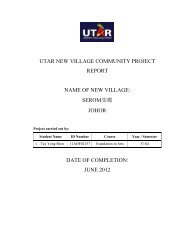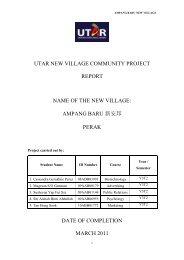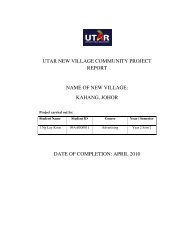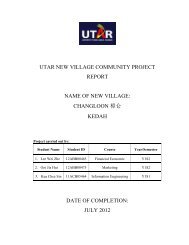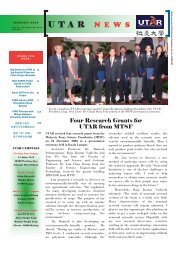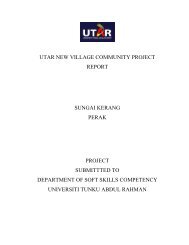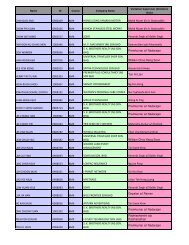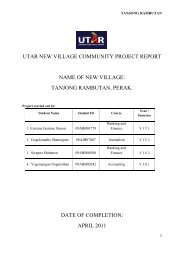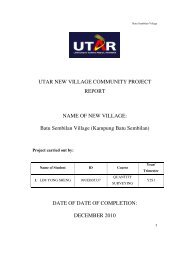UTAR NEW VILLAGE COMMUNITY PROJECT REPORT NAME OF ...
UTAR NEW VILLAGE COMMUNITY PROJECT REPORT NAME OF ...
UTAR NEW VILLAGE COMMUNITY PROJECT REPORT NAME OF ...
- No tags were found...
You also want an ePaper? Increase the reach of your titles
YUMPU automatically turns print PDFs into web optimized ePapers that Google loves.
<strong>UTAR</strong> <strong>NEW</strong> <strong>VILLAGE</strong> <strong>COMMUNITY</strong> <strong>PROJECT</strong><strong>REPORT</strong><strong>NAME</strong> <strong>OF</strong> <strong>NEW</strong> <strong>VILLAGE</strong>:SIMPANG 新 板PERAKProject carried out by:Student Name ID Number Course Year/ Semester1. Lee Ai Chun 10ABB00134 Accounting Y2S32. Lim Zue Yuan 10ABB00376 Marketing Y2S3DATE <strong>OF</strong> COMPLETION:MAY 2012
SIMPANGABSTRACTSimpang New Village is one of the 450 Chinese New Villages created during theMalayan Emergency. Simpang is located 4km away from Taiping, Perak. Farmingis the main economic activity. There are small plantations owned by villagers.Themain concerns of the villagers are too many stray dogs at this Village and agingpopulation.1
SIMPANGHISTORYNew villages are settlements created during the waning days of British ruleover Malaya in the mid-1950s. The original purpose of the New Villages inMalaysia was to segregate the villagers from the early Malayan Races LiberationArmy insurgents, which were led by the Malayan Communist Party, during theMalayan Emergency. This plan aimed to defeat the communists, who wereoperating out of rural areas as a guerrilla army, primarily by cutting them off fromtheir sources of support.Simpang New Village is one of the 450 Chinese New Villages createdduring the Malayan Emergency. Simpang is located 4km away from Taiping,Perak. Established in 1952, Simpang New Village currently has a population ofaround 2000 villagers with 264 houses. The name of the village comes from theroad junction where it is located “Simpang” means junction in Bahasa Malaysia.Simpang New Village is dominated by Hokkien Chinese people.2
SIMPANGPOPULATION AND HOUSINGCurrently, Simpang New Village has a population of around 2000 peoplewith 264 houses. According to village elders, the population in Simpang NewVillage has been decreasing over the past few decades. The villagers are made upof the 3 main races in Malaysia: Chinese, Indians and Malays. The Chinese madeup more than 80% of the total population in Simpang. The majority of villagersare 40-70 years old. Many residents from the younger generation have movedaway to the cities in search of better employment opportunities.A traditional Chinese New Village house is normally made of wood.However, there are 2 types of houses in Simpang New Village. Wooden housesand modern concrete houses. Over the years, many wooden houses have beendemolished and replaced by concrete houses.Traditional wooden house3
SIMPANGConcrete house with“modern” design4
SIMPANGECONOMIC ACTIVITIESThere are limited employment opportunities in Simpang New Village.Businesses in this village include coffee shops, small stalls and farms. Mostvillagers earn their income through these activities. Overall, farming is the maineconomic activity. There are small plantations owned by villagers. According tovillage elders, most villagers rearchickens and grow vegetables partly for theirown consumption and partly for sale.Some villagers open food stalls in coffee shops or in their own homes.There are also villagers who work in several factories in the village.A vegetable farm in the village5
SIMPANGSimpang Market6
SIMPANGEDUCATIONDue to the small population at Simpang New Village, it has only 1 school:SRJK (C) Sin Min Simpang Taiping. According to village elders, SRJK (C) SinMin was established more than 70 years ago at another village. However, thisprimary Chinese school was moved to Simpang in 1960.Currently, SRJK (C) Sin Min has 700 to 800 students and 30 to 40teachers. Most of the students and teachers not from Simpang New Village. ThisChinese school has a conducive environment for studies. Facilities at the schoolinclude a football field, a library, a computer lab, and adequate classroomsfor itsstudent population.SRJK(C) Sin Min Simpang,Taiping7
8SIMPANG
SIMPANGSOCIAL, CULTURAL AND RELIGIOUS PRACTICEIn Simpang village, most of the villagers are Chinese. In the past, mostvillage houses will display plaque of the family name/surname above the frontdoor. This practice overthe years and there are currently only a few traditionalhouseholds which display plaques of their surnames.Old-fashioned house with a plaque bearing the surname of the familyThe main religious in Simpang village are Taoism and Hinduism.Villagers of Simpang celebrate festivals such as Moon cake festival, Chinese NewYear festival, Winter Festival and Temple deity’s birthday( 晨 诞 ).9
SIMPANGTemple of “Kuam Tee” in Simpang10
SIMPANGA Taoist temple in SimpangA Hindu Temple in Simpang11
SIMPANGPROBLEMSThere are several problems faced by Simpang New Village. One of themajor problems is the many stray dogs at this Village. Villagers fear beingattacked by stray dogs. Besides, these dogs pose a health risk. For example, thesestray dogs rip open garbage bags and cause litter to be strewn around the street.Another problem for Simpang villagers is its aging population.Manyresidents from the younger generation have moved to urban areas in search ofbetter employment opportunities.Stray dogs are common in the village12
SIMPANGENTREPRENEURSHIP OPPORTUNITIESZoo Taiping has attracted many tourists to visit the tour of Taiping. Thiscreates entrepreneurship opportunities for villagers or Simpang because of itsclose proximity to Taiping. For example, Simpang villagers could openrestaurants or food stalls to cater to the demands of tourists.Besides, villagers may invest or be employed in the growing number ofhotels in the area. There are also opportunities to set up souvenir shops.13
SIMPANGTOURISM VALUESimpang New Village benefits from its proximity to Taiping Town.Themost popular tourist attraction in Taiping is Zoo Taiping. Established in 1961, ZooTaiping is the oldest zoo in Malaysia. It covers 34 acres and it has 1300 animalsrepresenting 180 species of amphibians, mammals and reptiles. Besides, visitorsduring the day, this zoo attract tourists for its night safari.Another tourism destination that may attract visitors will be Taiping WarCemetery which is located in Taiping also. Taiping War Cemetery is a graveyardfor those killed during World War 2. During the Japanese Invasion of Malaya,many soldiers including some from the Royal Malay Regiment, Gurkhas, Britishand Australian troops were killed. This has become an historical site that attractsmany tourists. Taiping War Cemetery is only 8km away from Simpang.Entrance to Taiping Zoo14
SIMPANGTigers at Taiping Zoo15
SIMPANGTaiping War Cemetery16
SIMPANGRECOMMENDATIONSIt is recommend that residents of Simpang New Village highlight theproblem of stray dogs to Majlis Perbandaran Taiping (MPT).The Council couldsend dog catches to the village.To deal with the problem of aging population, the authorities need to lookinto ways of injecting new businesses or economic activities which could retainthe younger generation in this village. Perhaps Simpang’s close proximity toTaiping Zoo, Taiping War Cemetery and other Taiping attractions could providemany entrepreneurial opportunities for villagers of Simpang, e.g. opportunities inthe food business, souvenir business and hotel industry.DISCLAIMER:Information contained in this report was compiled by the University’s students on voluntary basis.Although every effort has been made to check the accuracy of the report, the University accepts noresponsibility whatsoever for any errors or omissions, if any, the University reserves the right tomake changes on the information at any time without prior notice.Should there be any queries regarding contents of the report, please contact:Department of Soft Skills CompetencyTel: 03-78582628 ext8274, 8656, 8269 (Klang Valley Campus)05- 4688888 ext 2297/2299/2300 (Perak Campus)17



